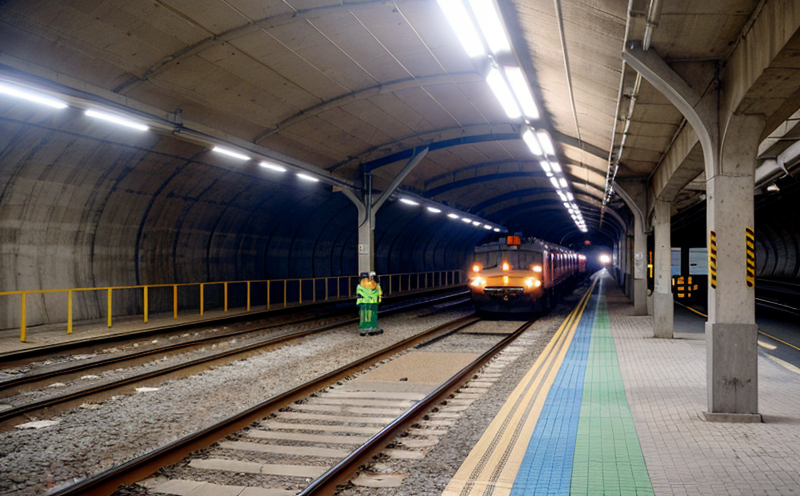EN 13232 Load Testing of Turnouts on Bridges
The European Standard EN 13232 is a critical document for the railway industry that provides detailed procedures for load testing turnouts installed on bridges. This standard ensures compliance with international safety and quality standards, which are essential in guaranteeing the reliability and longevity of turnout structures within bridge environments.
Turnouts on bridges face unique challenges due to the dynamic loading conditions caused by train movements. These tests help validate that the turnout geometry and mechanical components can withstand these specific loading patterns without compromising performance or safety. The testing process involves subjecting turnouts to forces that replicate real-world operating conditions, ensuring they function correctly under varying stresses.
The testing protocol outlined in EN 13232 specifies a series of steps for conducting the load tests. These include setting up the turnout according to the design parameters, applying loads progressively to simulate train passage, and monitoring performance indicators such as deflection, force distribution, and wear patterns. Compliance with this standard is mandatory for manufacturers and installers aiming to meet regulatory requirements in Europe.
The significance of these load tests extends beyond mere compliance—it ensures the structural integrity and operational reliability of railway systems. By adhering to EN 13232, quality managers, compliance officers, R&D engineers, and procurement teams can contribute significantly to enhancing safety and performance across the rail network. This standard is particularly important for projects involving new installations or modifications in existing infrastructure.
The testing process typically begins with a thorough inspection of the turnout’s design and materials. This includes reviewing blueprints, examining components such as points, stock rails, and the frog assembly, and ensuring all parts meet specified tolerances. Once the setup is complete, engineers apply loads incrementally to simulate different train speeds and weights.
Monitoring during load testing involves using advanced instrumentation like strain gauges, displacement sensors, and force transducers. These devices provide real-time data on how the turnout responds under stress, allowing for detailed analysis of its performance characteristics. The collected data is then compared against predefined acceptance criteria stipulated in EN 13232 to determine if the turnout meets all specified standards.
In addition to mechanical checks, visual inspections are conducted throughout the testing process to identify any potential issues that may arise due to excessive wear or damage. These observations help inform necessary adjustments and repairs before final certification is issued. Achieving compliance with EN 13232 not only enhances safety but also supports long-term cost savings by preventing premature failures and costly replacements.
Load testing of turnouts on bridges plays a crucial role in maintaining the integrity of railway infrastructure, ensuring smooth operations, and safeguarding public safety. As global demand for efficient transportation networks continues to grow, adherence to standards like EN 13232 becomes increasingly important.
Customer Impact and Satisfaction
- Enhanced Safety: Compliance with EN 13232 ensures that turnouts installed on bridges are safe for use, reducing the risk of accidents.
- Improved Reliability: Rigorous testing improves the reliability of railway systems by identifying potential issues early in the process.
- Longevity: Testing helps extend the lifespan of turnout structures through proactive maintenance and timely repairs.
- Regulatory Compliance: Meeting international standards like EN 13232 ensures that products meet legal requirements, avoiding penalties and delays.
- Cost Efficiency: By preventing failures, load testing saves money on replacement parts and labor costs in the long run.
- Customer Trust: Demonstrating adherence to recognized standards fosters trust among stakeholders and enhances overall reputation.
Environmental and Sustainability Contributions
The load testing of turnouts on bridges conducted according to EN 13232 contributes positively to environmental sustainability by promoting efficient use of resources. By ensuring that turnout structures are durable and reliable, the process helps minimize waste associated with premature failures. This translates into reduced material consumption and lower carbon footprints over the lifecycle of railway infrastructure.
Furthermore, by enhancing safety and reliability, EN 13232 supports sustainable transportation systems that can operate efficiently without frequent disruptions. Efficient rail networks are key to reducing dependency on less environmentally friendly modes of transport like road vehicles, thereby contributing to global efforts towards emission reduction goals set forth in international agreements such as the Paris Agreement.
Through meticulous testing and compliance with recognized standards, this service plays a vital role in advancing sustainable practices within the railway industry. It helps pave the way for more resilient and environmentally conscious transportation solutions that benefit both society and future generations.
Competitive Advantage and Market Impact
The implementation of EN 13232 load testing services provides significant competitive advantages for companies operating in the railway sector. By ensuring that their products meet stringent international standards, these firms can establish a strong reputation for quality and reliability among customers. This not only enhances brand image but also opens up opportunities to secure contracts from reputable clients who prioritize safety and compliance.
Moreover, adherence to such high-quality testing protocols demonstrates commitment to sustainability and environmental responsibility. In an increasingly environmentally conscious market, this approach can attract eco-conscious consumers seeking sustainable products. For procurement teams looking for reliable suppliers, choosing partners who comply with standards like EN 13232 signals a shared commitment to excellence.
In terms of market impact, meeting these stringent requirements positions companies as leaders in their field. It sets benchmarks that others must strive to match or exceed, fostering innovation and driving technological advancements within the industry. By staying ahead of regulatory changes and evolving best practices, firms can maintain leadership positions and secure competitive edges over less diligent competitors.





